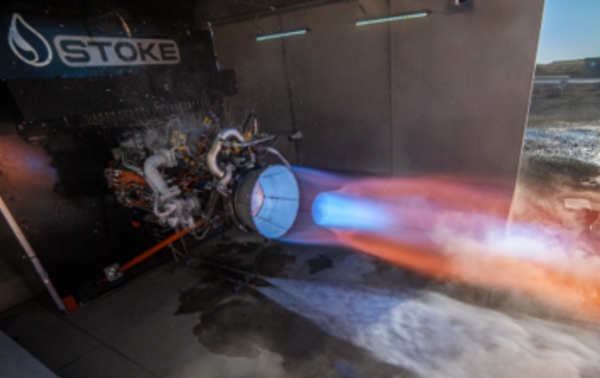WASHINGTON — Stoke Space has test-fired a highly efficient engine it is developing for the first stage of its fully reusable launch vehicle.
The company, based in Kent, Washington, announced June 11 that it performed a brief firing of the engine at a test site in Moses Lake, Washington, on June 5. The engine, designed to produce up to 100,000 pounds-force of thrust, went up to 50% of its rated thrust in the two-second test.
The goal of the test was to see how the engine started up and shut down, Andy Lapsa, chief executive of Stoke, said in an interview. “All of the complexity and a lot of the risk is in that startup transient and shutdown transient,” he said. “The duration of the test was short because the goal was to demonstrate the transient and then back out.”

The engine uses a design called full-flow staged combustion, where both the engine’s fuel and oxidizer — liquified natural gas and liquid oxygen, respectively — go through separate preburners before going into the main combustion chamber. That approach offers greater efficiency and a longer engine life, but is more complex to develop. It is currently used only on SpaceX’s Raptor engines that power its Starship vehicle.
Lapsa said Stoke chose this approach because it was needed for rapidly reusable launch vehicles. “In a world of rapid reuse, you need high performance,” he said. “Full-flow stage combustion gives you the highest performance possible under the least stressing conditions.”
Testing of the engine is currently focused on the transient conditions at startup and shutdown. The company is building a larger test stand that will be completed later this summer that will enable longer-duration tests, including a full qualification test campaign.
Stoke plans to use seven of the engines on the first stage of Nova, the fully reusable medium-lift launch vehicle it is developing. The upper stage uses a very different engine technology, with liquid oxygen and liquid hydrogen fueling an engine integrated into an actively cooled heat shield to allow the upper stage to return for a powered landing. The company tested that system with a flight of a prototype “hopper” last September.
Lapsa said there is some commonality between the booster and upper stage engines in areas like technology used in the engines’ turbomachinery, as well as analysis tools. “Other than that, it is very much an entirely new and different system.”
Stoke is making progress on other aspects of the vehicle. The engine tests used flight avionics and software, he said, and the company is doing a “design iteration” on the upper stage. That work is being funded by a $100 million Series B round the company raised last October.
“In a lot of ways all systems are go and the last big question mark that I felt carrying on my shoulders was the first stage engine, and specifically getting the engine through the transients and back successfully,” he said.
Lapsa said after the hopper test last September that the company had an internal goal of beginning orbital flight tests in 2025, with a desire to accelerate that schedule where possible. He declined to give an updated schedule after this engine test, saying that will depend on when the company can start work on the vehicle’s launch site at Cape Canaveral’s Launch Complex 14, which the Space Force allocated to Stoke last year.
He noted that the test took place just 18 months after the company started to design the engine. “I think that you’ll find over time, just like fully rapidly reusable rockets will render all others obsolete, I think that these high-performing engines that make that mission possible will render over time the lower performing variants also obsolete,” he said. “I think it’s an essential technology mountain to climb, and I’m really excited to be on that mountain.”
- SEO Powered Content & PR Distribution. Get Amplified Today.
- PlatoData.Network Vertical Generative Ai. Empower Yourself. Access Here.
- PlatoAiStream. Web3 Intelligence. Knowledge Amplified. Access Here.
- PlatoESG. Carbon, CleanTech, Energy, Environment, Solar, Waste Management. Access Here.
- PlatoHealth. Biotech and Clinical Trials Intelligence. Access Here.
- Source: https://spacenews.com/stoke-space-test-fires-new-booster-engine/



